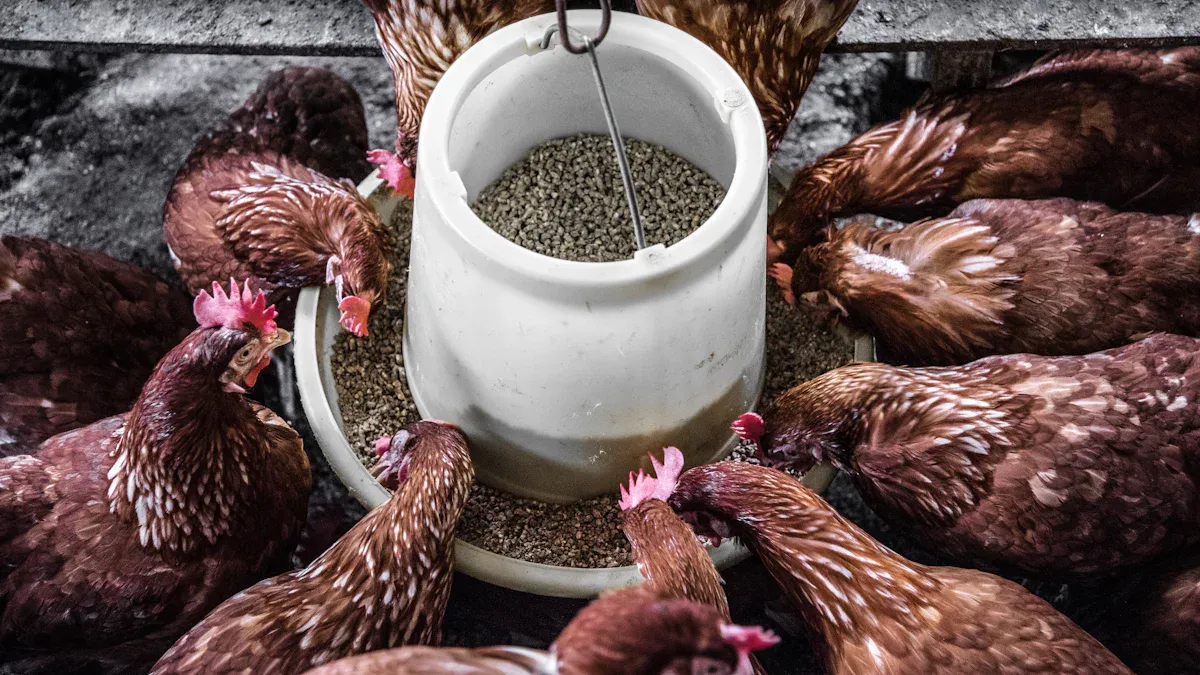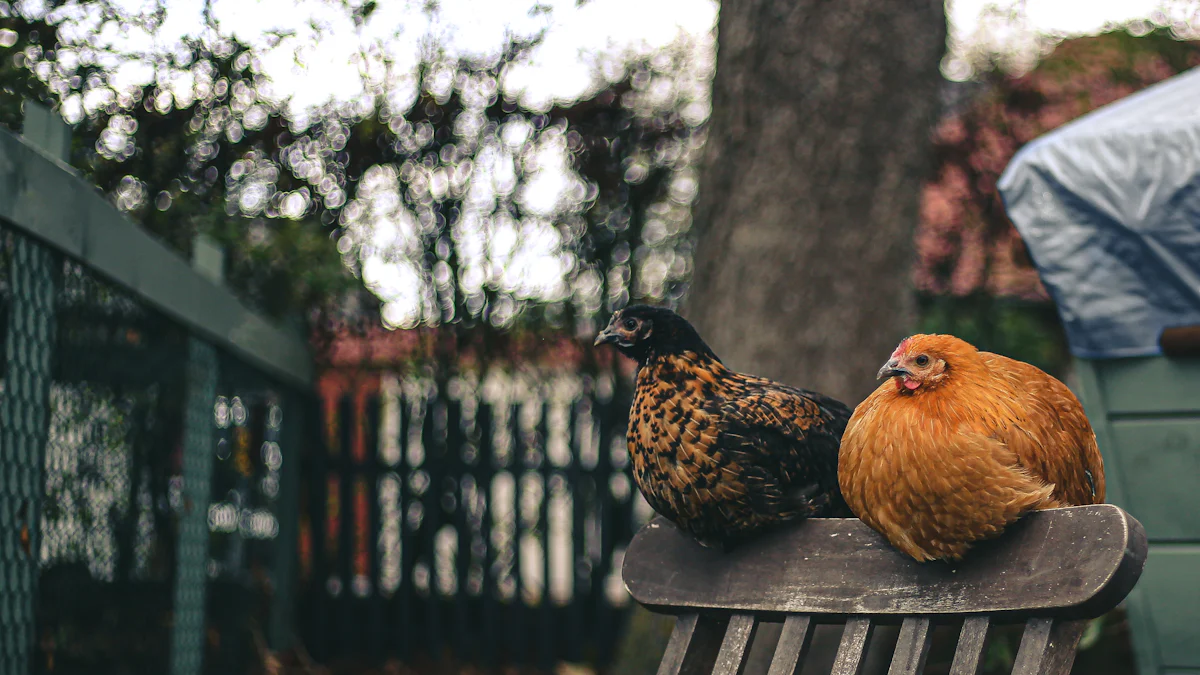
Dried mealworms for poultry pack a powerful punch when it comes to nutrition. They’re loaded with protein—over 51%—and essential nutrients like fats, amino acids, and minerals. Studies show they improve growth, digestion, and even meat quality. Plus, their chitin content promotes gut health by reducing harmful bacteria. Talk about a superfood!
Key Takeaways
- Dried mealworms are full of nutrients, with over 51% protein. They have important nutrients that help poultry grow and stay healthy.
- Adding mealworms to poultry food can make feeding cheaper. It also helps birds lay more eggs and have better feathers.
- Feeding dried mealworms makes birds search for food naturally. This keeps them happy, active, and supports the environment.
Nutritional Benefits of Dried Mealworms For Poultry
High Protein Content
Protein is the building block of life, and dried mealworms for poultry deliver it in abundance. With over 51% protein content, they outshine many traditional feed options. Studies reveal that incorporating mealworms into poultry diets improves the feed conversion ratio (FCR), meaning birds get more nutrition from less feed. This efficiency not only boosts growth but also reduces feed costs.
Here’s a quick comparison of protein content across different feed types:
| Feed Type | Protein Content | Notes |
|---|---|---|
| Control Feed (Agar) | N/A | Baseline for comparison. |
| Vegetable Mix | Higher | Increased crude ash, fat, and protein content compared to control. |
| Potato Cuttings | Decreased | Resulted in lower protein, chitin, and non-fiber carbohydrates. |
Mealworms also improve protein utilization, making them a cost-effective and nutritious choice for poultry keepers.
Rich in Essential Nutrients
Dried mealworms for poultry are more than just protein powerhouses. They’re packed with essential nutrients like fats, amino acids, and minerals. These nutrients play a vital role in energy production, muscle development, and immune system support.
Take a look at this chart showcasing the nutrient breakdown in mealworms compared to other diets:

This nutrient density ensures that poultry stay healthy and thrive, even in demanding conditions.
Benefits for Egg Production, Feather Quality, and Overall Health
Adding dried mealworms to a poultry diet can work wonders for egg production. The high protein and fat content contribute to stronger eggshells and richer yolks. Birds also benefit from improved feather quality, which is essential for insulation and protection.
Moreover, the chitin in mealworms promotes gut health by reducing harmful bacteria. Healthier birds mean fewer illnesses and better productivity. Whether you’re raising chickens for eggs or meat, mealworms are a game-changer.
How to Use Dried Mealworms For Poultry

Incorporating Mealworms into Poultry Diets
Adding dried mealworms to poultry diets is simple and effective. These nutrient-packed treats can be mixed directly into regular feed or offered as a standalone snack. Many poultry keepers prefer sprinkling mealworms over the feed to encourage birds to eat more enthusiastically. This method works especially well for picky eaters or during colder months when birds need extra energy.
Research highlights the benefits of including mealworms in varying amounts. For instance, studies show that incorporating 50 to 150 grams of mealworms per kilogram of feed leads to steady weight gain and improved growth performance. Here’s a quick look at some findings:
| Study | Mealworm Inclusion (g/kg) | Key Findings |
|---|---|---|
| Biasatu et al. | 50, 100, 150 | Mean body weight and daily weight gain increased linearly with mealworm inclusion. |
| Ballitoc and Sun | 0 to 100 | Improved growth performance observed. |
| Bovera et al. | Up to 296 | Positive effects on growth performance noted. |
Mealworms also pair well with other protein sources, like soybean meal, to create a balanced diet. Their versatility makes them a valuable addition to any feeding routine.
Feeding Quantities and Frequency
Feeding the right amount of dried mealworms is essential for maintaining poultry health. Experts recommend starting with small quantities and gradually increasing the inclusion level. For optimal results, studies suggest using up to 15% mealworm replacement in the diet. This level improves nutrient digestibility and enhances carcass characteristics without increasing feed intake.
Here’s a breakdown of feeding recommendations:
| Study | Inclusion Level (g/kg) | Result |
|---|---|---|
| Biasatu et al. | 50, 100, 150 | Increased mean body weight and daily gain. |
| Ballitoc and Sun | 0 to 100 | Improved growth performance. |
| Bovera et al. | 296 | Positive effects on growth. |
| Fink | 15% replacement | Maintained fat digestibility. |
| General Findings | 15% replacement | Reduced feed intake, improved carcass characteristics. |
Poultry keepers should feed mealworms 2-3 times a week as a supplement rather than a primary food source. This ensures birds receive a balanced diet while enjoying the benefits of dried mealworms for poultry.
Cost-Effectiveness and Safety of Dried Mealworms For Poultry
Comparing Costs with Other Feed Options
When it comes to feeding poultry, cost is always a big factor. Dried mealworms for poultry might seem pricey at first glance, but they offer unique advantages that can make them worth the investment. Studies show that mealworms are a rich source of protein and energy, which can help reduce the need for other expensive protein supplements. This can lower overall nutritional expenses in poultry diets.
However, it’s important to note that while mealworms can cut protein costs, they may increase total feed costs. Why? Because they’re a premium ingredient. But here’s the good news: the benefits often outweigh the costs. Healthier birds, better egg production, and improved growth performance can lead to higher revenue for poultry keepers.
For those on a tight budget, mealworms don’t have to replace traditional feed entirely. Instead, they can be used as a supplement to enhance the overall diet. This approach balances cost and nutrition effectively.
Ensuring Quality and Avoiding Contamination
Quality matters when feeding poultry. Not all dried mealworms are created equal, so choosing a reliable supplier is crucial. Look for mealworms that are free from additives, pesticides, and harmful chemicals. High-quality mealworms should also be properly dried to prevent mold or bacterial growth.
To ensure safety, store mealworms in a cool, dry place. Airtight containers work best to keep them fresh and free from pests. Regularly check for signs of spoilage, like an unusual smell or discoloration. Feeding contaminated mealworms can harm poultry health, so it’s better to be cautious.
By prioritizing quality and proper storage, poultry keepers can maximize the benefits of dried mealworms while keeping their flocks safe and healthy.
Additional Benefits of Dried Mealworms For Poultry
Encouraging Natural Foraging Behavior
Dried mealworms for poultry do more than just provide nutrition—they also encourage natural behaviors. Chickens, ducks, and other poultry love to forage. Tossing mealworms into their environment mimics the act of hunting for insects in the wild. This keeps birds active and engaged, which is great for their mental and physical health.
Foraging also helps reduce boredom, a common issue in confined spaces. Birds that stay busy are less likely to develop bad habits like feather pecking or aggression. Mealworms can even be used as a training tool. Scattering them around encourages birds to explore their surroundings, creating a more enriching environment.
Promoting Sustainability and Reducing Food Waste
Mealworms are not just good for poultry—they’re good for the planet too. Studies show that producing mealworms has a much smaller environmental footprint compared to traditional livestock. For example, producing 1 kg of edible mealworm protein emits only 20.4 kg of CO2, far less than beef or pork. It also uses less energy and land, making it a sustainable choice.
Mealworms can also help reduce food waste. They thrive on organic waste, turning scraps into high-quality protein. This makes them an eco-friendly option for poultry keepers looking to minimize their environmental impact. By incorporating mealworms into poultry diets, farmers can support sustainability while providing their flocks with a nutritious treat.
Dried mealworms are a game-changer for poultry keepers. They’re packed with nutrients, improve growth, and boost productivity. Compared to soybean meal, mealworms offer higher protein content (51.93% vs. 44.51%) and better feed efficiency.
- Key benefits:
- Enhanced growth performance.
- Cost-effective protein source.
- Supports natural behaviors.
Adding mealworms is a simple way to keep poultry thriving! 🐓
FAQ
What makes dried mealworms better than other protein sources?
Dried mealworms offer higher protein content (over 51%) and better digestibility compared to many traditional feeds. They also provide essential nutrients like fats, amino acids, and minerals.
Can dried mealworms replace all other poultry feed?
No, dried mealworms should supplement a balanced diet. They work best as an addition to regular feed, enhancing nutrition without replacing essential grains or other protein sources.
How should dried mealworms be stored?
Store them in a cool, dry place using airtight containers. This prevents spoilage and keeps them fresh for longer, ensuring your poultry gets the best quality feed.


